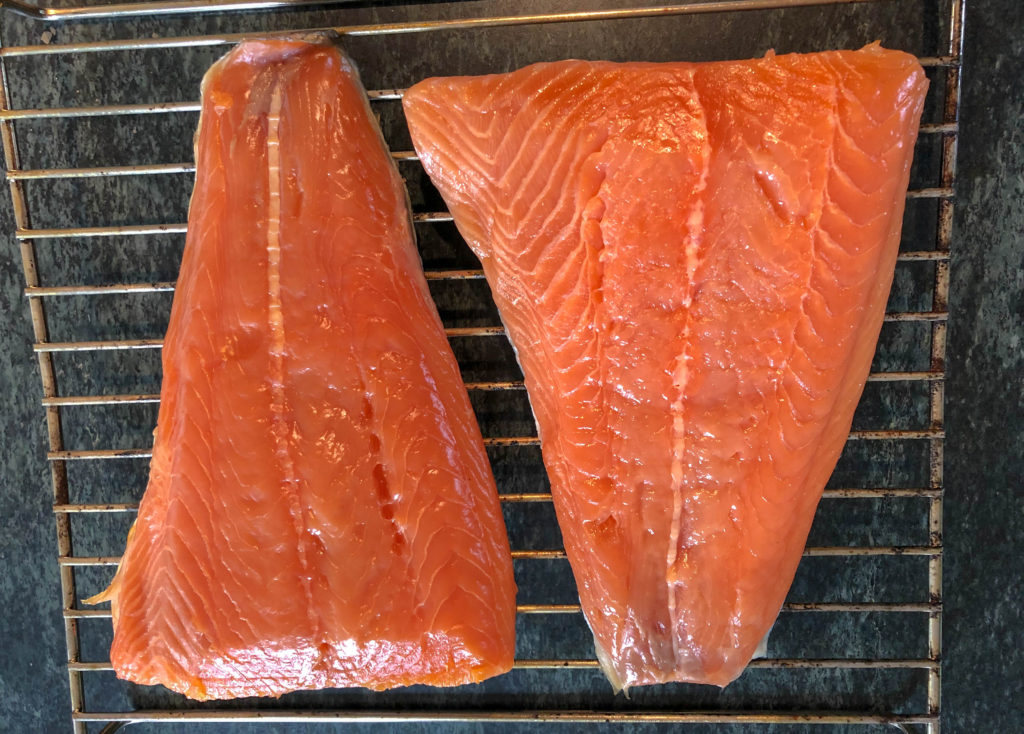
Imagine you’ve caught a lot of gorgeous, fat salmon and there’s only so much of it you can eat in one sitting. Also, you’re a hardened Viking fisherman, you’re standing on a cold beach, and you don’t want to mess around too much with recipes.
How about if you gut and fillet the fish, dig a pit in the sand, add some bark and pine needles, and cover it back up? With a bit of luck it will ferment and turn into the original gravlax, which translates into “buried fish.”
I am definitely going to try that out one day, but as with sushi (which was also originally made with preserved fish), gravlax has become something you can do relatively quickly, and without a beach or a shovel. The key to the whole thing these days is salt and maybe a little pressure, all to get enough water out of the fish so as to concentrate its flavor, and keep it edible beyond its normal span of days.
Gravlax is more process than recipe, and I go through the steps in as much detail as you need and I can stand in this page from our deli chronicles. If you’re a gravlax virgin, about to be salted and squished for the very first time, it’s worth a read. Otherwise, let’s plunge ahead with a few exemplary recipes that you can be eating as soon as 24 hours from now, and even cold smoke into the true lox of your dreams.
My Grandpa Maier’s Gravlax was inspired by the old gentleman himself. He owned a men’s wear shop in Philadelphia and was a great salesman, tailor and pinochle player, as well as a friend of Leon Trotsky’s. He also loved rye whiskey. This is my basic go-to gravlax recipe. It permits of many variations and is a great place to start. For very complete and generic gravlaxing instructions, check out this chronicle. If you want to go the extra mile and cold-smoke the results into the true lox of your dreams (and if you have a galvanized steel trash can handy) try this link.
Grandpa Maier’s Gravlax
My go-to gravlax recipe - classic flavors with a citrus twist and rye spice.

This recipe puts optional liquor and spices directly on the fish. Turning is unnecessary, but draining is important to control saltiness, and to help the salmon dry out. The goal is to get around 10% of the moisture out of the fish, which takes around three days PLUS a little air drying overnight in the fridge, or about an hour under an ordinary room fan.
Rye is nice to use here because of its spice notes, but you could omit alcohol altogether, or use an alternative liquor and make any adjustments you prefer. Meaning: with clear liquors like gin or citrus vodka, I normally use white sugar. With tequila, I like to add some finely sliced fresh, hot serrano or jalapeno chilis. Fresh dill goes very well with gin or aquavit. And so on.
Trim your fish of any remaining belly flap (see below), and pull out any pin bones that your friendly fishmonger missed. Give the fish a nice rinse in cold water, and pat dry. Pour on the liquor, if you are using it, and rub in gently. If you want a very clean final appearance, omit the fennel seeds (they tend to dig themselves into the fish) and mix together the whole peppercorns and coriander seed with the salt and sugar. If you are OK with a homier look (as with my pastrami-cured specimen up top), coarsely grind or crack the spices in a coffee mill, mortar or spice grinder, and put them directly on the fish.
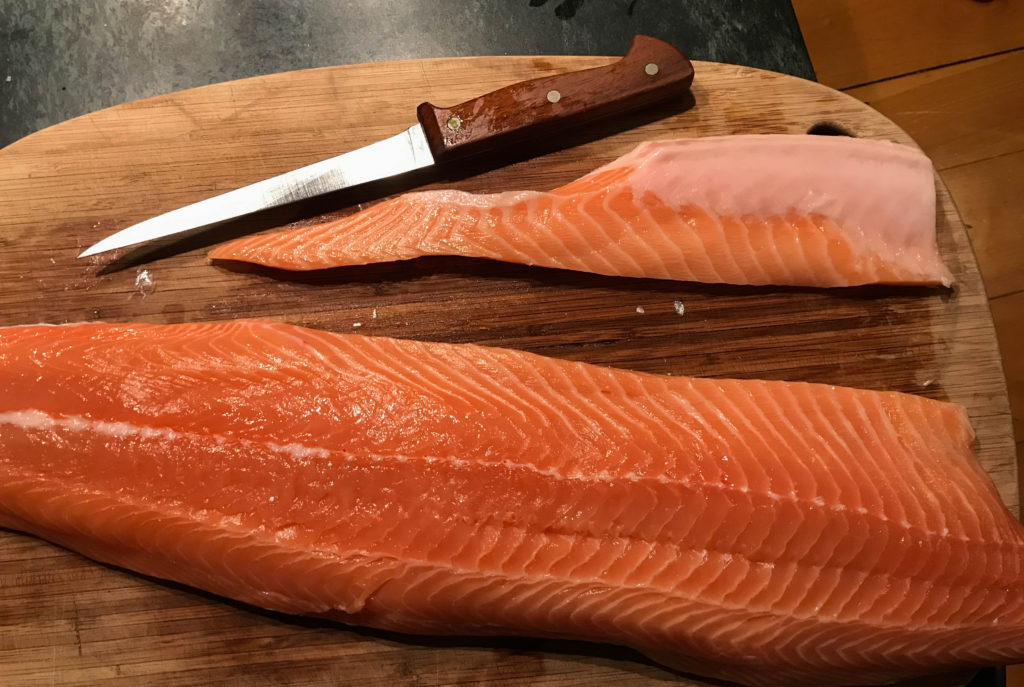
Mix together the sugar, salt, whole spices if you are using them, and the grated citrus rinds. Find a baking dish a bit bigger than the salmon. Lay down about a third of the sugar/salt mix, and put the fish, skin-side down, on top. Spread the remaining mix directly on the flesh of the fish, piling it up a bit more where the flesh is thickest. Cover by draping a layer of plastic wrap over all, and then a sheet of aluminum foil.

Optionally, weigh the fish down with a foil-wrapped brick or other heavy object (a food container filled with water is a good choice) and refrigerate. The salt and sugar mix will draw out a reasonable amount of salmon liquid in the first 24 hours. This will mix with the salt itself to become very salty indeed, and should be drained or it will reabsorb. My general rule is to drain once after about 12 hours, once again 12 hours or so later, and after that just once a day, if it's even needed.
The picture below shows me sneaking a peek at some gravlax after its initial 12 hours. There's about a quarter inch of liquid in the bottom of the dish, coming well up onto the flesh of the fish. This should definitely be drained.
Worriers note: you don't have to turn the fish - that's really for recipes where you make a kind of sandwich out of two fillets, with the salt in the middle.
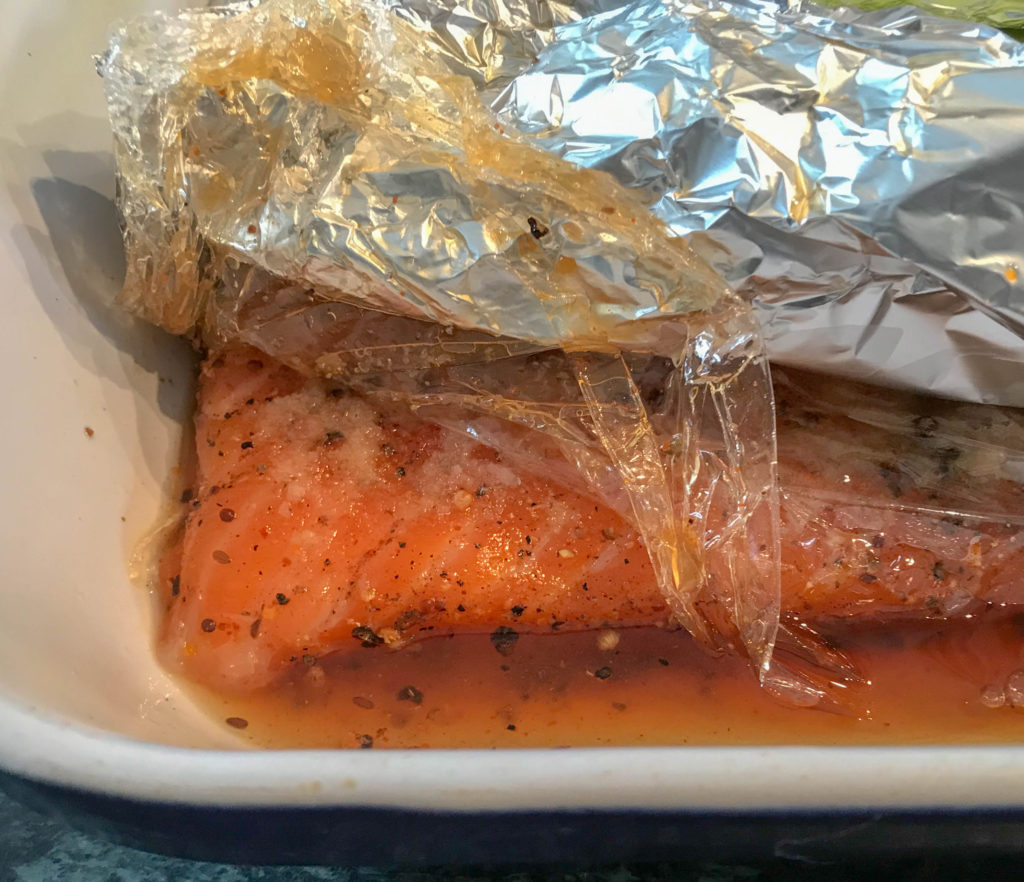
In a pinch (or for some recipes where you want a moister end product) I have served gravlax after just 24 hours. That said, I think an ideal gravlax schedule is about three days in the fridge, but it can easily sit, under its dry cure, for a week or more, if you're not ready for it.
If you're using the direct-to-fish route with your liquor and spices, and definitely if you're planning on cold-smoking your fish after its salt cure, do this: remove the fish from its dish, give it a minimal rinse in cold running water and pat dry both sides with paper towels. Give the flesh an extra sprinkle of liquor and spices, rub in gently, and let the fish sit, uncovered on a rack in the fridge for another twelve hours or overnight. Alternatively, give it just one hour on a rack in front of an ordinary room fan for the exact same result. This will freshen up the flavor, give the fish a slight gloss called a pellicle that I find attractive, and pull out an extra 1 or 2% of moisture. The pellicle, with its slight stickiness, is practically a necessity for cold-smoking, as it allows the smoke particles to adhere evenly.
It's now been a few days, but you've done little actual work. Lay the fish out and slice thinly on the bias with a very sharp knife. This part should be fun! If it's not, you just have to practice until it is. There is no piece of gravlax so thick or misshapen that I won't eat it, but you can always make lox and eggs. Just make sure you're using a sharp knife. If you're new to this, I envy you.
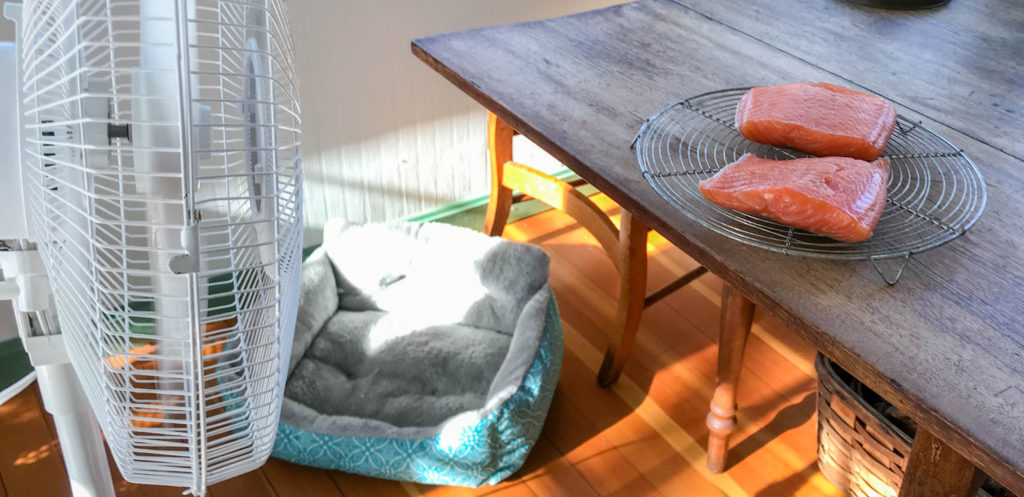
To make pastrami-cured gravlax, simply follow the directions above, making sure you grind the spices coarsely, and put them and the brown liquor of your choice (aquavit or rye are particularly recommended) directly on the fish before adding the salt mix. Hold back an extra bit of liquor and teaspoon or two of spice for the final drying out in the fridge. If you're not going to cold-smoke the end result, a scant teaspoon of smoked paprika added to the spice will add a bit of color and smoked flavor For a full on pastrami mix, try our recipe here.
For a more Mexican flavor, use tequila in the above recipe, double the amount of citrus rind, and for every pound of fish mix a thinly sliced green or red hot chili (serrano or jalapeno, seeds included) with the sugar, salt and other spices. If you're using a silver tequila, I think white sugar allows more of the cactus flavor to shine, but for a reposado or anejo liquor, stick with the brown.
Traditional Scandinavian recipes often call for gin or aquavit and a few sprigs of fresh dill, which can be added directly to the original recipe above. The fresh herbs are very nice, and you can also add some dill seed. When I'm making a lot for the holidays I often go this route, and actually make up two full, matching fillets of four or five pounds each, cured sandwich-style (skin sides out) in the fish poacher. The lifter makes it easy to pull up the salmon for drainage and turning. My typical aim is to bring one fillet to the family event, and leave the other at home, for later.
Fish cured sandwich-style should have about half the salt mix in the middle, along with the fresh dill and other spices, with the remaining cure split between the top and bottom. This is the one case where you really do need to flip the fish daily, so the bottom filet won't come out much saltier than the one on top. These recipes also seem to take longer, needing around five days before they stop producing extra liquid.
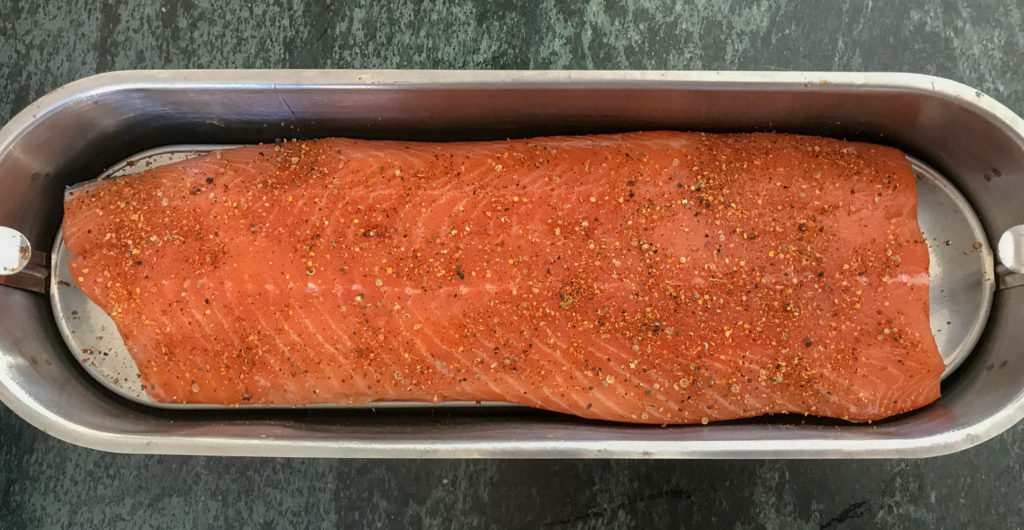
A lot of commercial lox has very little smoke flavor, but you can fix that. It is huge fun to cold-smoke your own fish. All it takes is a tiny bit of backyard, a metal trash can, a gizmo like the A-Maze-N smoker, and these simple instructions. How long you smoke is mainly up to you, but with the A-Maze-N gizmo, a light smoke would be one or two hours with just one end lit; a heavy smoke would be six hours with both sides going.
Do please keep in mind that cold-smoking is NOT meant to cook the fish. In fact, you shouldn't attempt to cold-smoke fish outdoors if the temperature is above the mid sixties (F), as salmon actually starts to gelatinize somewhere above eighty degrees. You can also use the cold-smoke technique to lay a smoked flavor on many foods that will be heated later in the process, including pastrami, finnan haddie, and bacon.

Ingredients
Directions
This recipe puts optional liquor and spices directly on the fish. Turning is unnecessary, but draining is important to control saltiness, and to help the salmon dry out. The goal is to get around 10% of the moisture out of the fish, which takes around three days PLUS a little air drying overnight in the fridge, or about an hour under an ordinary room fan.
Rye is nice to use here because of its spice notes, but you could omit alcohol altogether, or use an alternative liquor and make any adjustments you prefer. Meaning: with clear liquors like gin or citrus vodka, I normally use white sugar. With tequila, I like to add some finely sliced fresh, hot serrano or jalapeno chilis. Fresh dill goes very well with gin or aquavit. And so on.
Trim your fish of any remaining belly flap (see below), and pull out any pin bones that your friendly fishmonger missed. Give the fish a nice rinse in cold water, and pat dry. Pour on the liquor, if you are using it, and rub in gently. If you want a very clean final appearance, omit the fennel seeds (they tend to dig themselves into the fish) and mix together the whole peppercorns and coriander seed with the salt and sugar. If you are OK with a homier look (as with my pastrami-cured specimen up top), coarsely grind or crack the spices in a coffee mill, mortar or spice grinder, and put them directly on the fish.

Mix together the sugar, salt, whole spices if you are using them, and the grated citrus rinds. Find a baking dish a bit bigger than the salmon. Lay down about a third of the sugar/salt mix, and put the fish, skin-side down, on top. Spread the remaining mix directly on the flesh of the fish, piling it up a bit more where the flesh is thickest. Cover by draping a layer of plastic wrap over all, and then a sheet of aluminum foil.

Optionally, weigh the fish down with a foil-wrapped brick or other heavy object (a food container filled with water is a good choice) and refrigerate. The salt and sugar mix will draw out a reasonable amount of salmon liquid in the first 24 hours. This will mix with the salt itself to become very salty indeed, and should be drained or it will reabsorb. My general rule is to drain once after about 12 hours, once again 12 hours or so later, and after that just once a day, if it's even needed.
The picture below shows me sneaking a peek at some gravlax after its initial 12 hours. There's about a quarter inch of liquid in the bottom of the dish, coming well up onto the flesh of the fish. This should definitely be drained.
Worriers note: you don't have to turn the fish - that's really for recipes where you make a kind of sandwich out of two fillets, with the salt in the middle.

In a pinch (or for some recipes where you want a moister end product) I have served gravlax after just 24 hours. That said, I think an ideal gravlax schedule is about three days in the fridge, but it can easily sit, under its dry cure, for a week or more, if you're not ready for it.
If you're using the direct-to-fish route with your liquor and spices, and definitely if you're planning on cold-smoking your fish after its salt cure, do this: remove the fish from its dish, give it a minimal rinse in cold running water and pat dry both sides with paper towels. Give the flesh an extra sprinkle of liquor and spices, rub in gently, and let the fish sit, uncovered on a rack in the fridge for another twelve hours or overnight. Alternatively, give it just one hour on a rack in front of an ordinary room fan for the exact same result. This will freshen up the flavor, give the fish a slight gloss called a pellicle that I find attractive, and pull out an extra 1 or 2% of moisture. The pellicle, with its slight stickiness, is practically a necessity for cold-smoking, as it allows the smoke particles to adhere evenly.
It's now been a few days, but you've done little actual work. Lay the fish out and slice thinly on the bias with a very sharp knife. This part should be fun! If it's not, you just have to practice until it is. There is no piece of gravlax so thick or misshapen that I won't eat it, but you can always make lox and eggs. Just make sure you're using a sharp knife. If you're new to this, I envy you.

To make pastrami-cured gravlax, simply follow the directions above, making sure you grind the spices coarsely, and put them and the brown liquor of your choice (aquavit or rye are particularly recommended) directly on the fish before adding the salt mix. Hold back an extra bit of liquor and teaspoon or two of spice for the final drying out in the fridge. If you're not going to cold-smoke the end result, a scant teaspoon of smoked paprika added to the spice will add a bit of color and smoked flavor For a full on pastrami mix, try our recipe here.
For a more Mexican flavor, use tequila in the above recipe, double the amount of citrus rind, and for every pound of fish mix a thinly sliced green or red hot chili (serrano or jalapeno, seeds included) with the sugar, salt and other spices. If you're using a silver tequila, I think white sugar allows more of the cactus flavor to shine, but for a reposado or anejo liquor, stick with the brown.
Traditional Scandinavian recipes often call for gin or aquavit and a few sprigs of fresh dill, which can be added directly to the original recipe above. The fresh herbs are very nice, and you can also add some dill seed. When I'm making a lot for the holidays I often go this route, and actually make up two full, matching fillets of four or five pounds each, cured sandwich-style (skin sides out) in the fish poacher. The lifter makes it easy to pull up the salmon for drainage and turning. My typical aim is to bring one fillet to the family event, and leave the other at home, for later.
Fish cured sandwich-style should have about half the salt mix in the middle, along with the fresh dill and other spices, with the remaining cure split between the top and bottom. This is the one case where you really do need to flip the fish daily, so the bottom filet won't come out much saltier than the one on top. These recipes also seem to take longer, needing around five days before they stop producing extra liquid.

A lot of commercial lox has very little smoke flavor, but you can fix that. It is huge fun to cold-smoke your own fish. All it takes is a tiny bit of backyard, a metal trash can, a gizmo like the A-Maze-N smoker, and these simple instructions. How long you smoke is mainly up to you, but with the A-Maze-N gizmo, a light smoke would be one or two hours with just one end lit; a heavy smoke would be six hours with both sides going.
Do please keep in mind that cold-smoking is NOT meant to cook the fish. In fact, you shouldn't attempt to cold-smoke fish outdoors if the temperature is above the mid sixties (F), as salmon actually starts to gelatinize somewhere above eighty degrees. You can also use the cold-smoke technique to lay a smoked flavor on many foods that will be heated later in the process, including pastrami, finnan haddie, and bacon.

